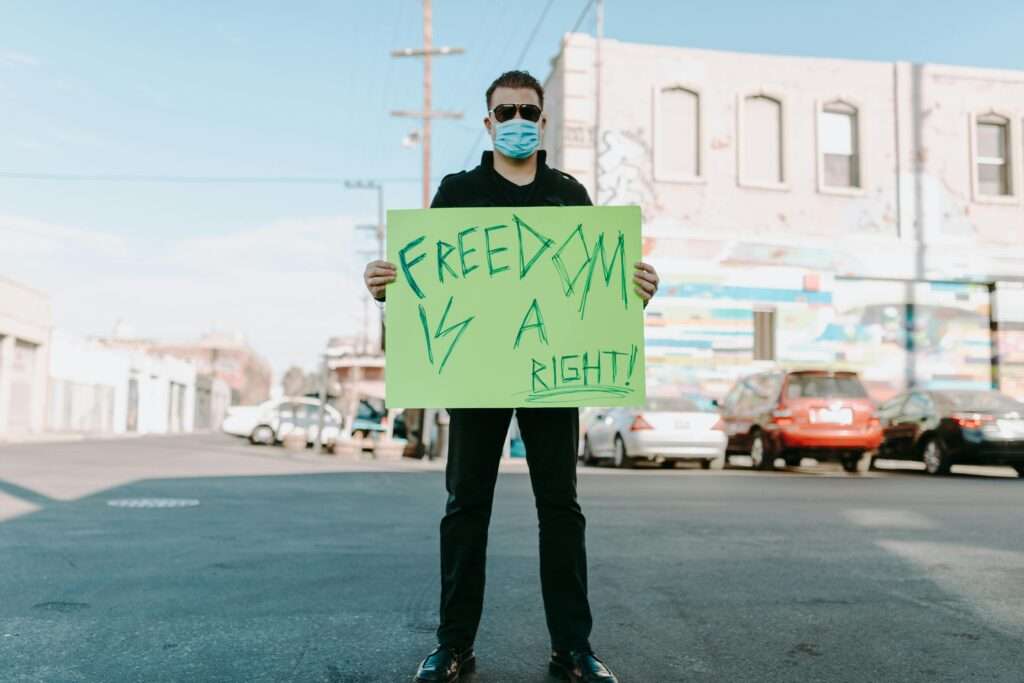Contact
Get In Touch

Author
Abdul Azeem
LLB (Hons) LLM
The Right to Protest in Pakistan
In Pakistan, a vibrant and dynamic democracy, the right to protest is an essential expression of civic engagement and democratic participation. This right allows citizens to voice their opinions, demand accountability, and contribute to societal and political discourse. As a tool for public expression, protests play a crucial role in influencing policy decisions and shaping the nation’s future.

Constitutional Basis for the Right to Protest
The Constitution of Pakistan enshrines the freedom of assembly as a fundamental right in Article 16. This article guarantees every citizen the right to assemble peacefully and without arms, subject to reasonable restrictions imposed in the interest of public order. This constitutional provision is a testament to Pakistan’s commitment to upholding democratic values and ensuring avenues for public discourse.
Historical Context of Protests in Pakistan
Throughout Pakistan’s history, protests have been pivotal in driving political and social change. From the movement for democracy to recent demonstrations advocating for human rights and government accountability, the power of public assembly has been evident. These events have not only shaped the political landscape but also highlighted the strength and resilience of the Pakistani people in advocating for their human rights and freedoms.
Legal Framework Governing Protests
While the right to protest is constitutionally protected, it operates within a legal framework that includes public order and safety regulations. Organizers of public assemblies often need to navigate legal requirements, such as obtaining permissions and adhering to specified guidelines. These laws are designed to balance the right to protest with the responsibility to maintain public order and safety.
The exercise of the right to protest in Pakistan is not without challenges. Instances of clashes between law enforcement and protesters, restrictions imposed on assemblies, and debates over the extent of this right underscore the ongoing struggle to balance security concerns with freedom of expression. These challenges necessitate a continuous dialogue on the role and limits of peaceful assembly in a democratic society.
International Standards and Comparisons
Pakistan’s approach to the right to protest reflects a broader commitment to international human rights standards. The country’s legal framework is aligned with global norms that advocate for peaceful assembly as a fundamental right. Comparisons with other democracies reveal diverse methods of managing and facilitating public protests, offering insights for potential reforms and best practices.
Civil society organizations and NGOs in Pakistan actively support the right to protest by providing platforms for peaceful assembly, legal assistance, and advocacy. These groups play a crucial role in protecting protesters’ rights, educating the public on legal provisions, and fostering a culture of non-violent and constructive protest.
Public Participation and Awareness
Public awareness about the legal and ethical aspects of protesting is crucial for the effective exercise of this right. Educational initiatives and campaigns aim to inform citizens about their rights, the importance of non-violence, and the impact of civic actions in driving societal change.
The right to protest remains a cornerstone of democracy in Pakistan, embodying the spirit of civic engagement and public participation. Encouraging responsible and informed protesting can lead to constructive dialogue, meaningful change, and a stronger democratic fabric in the country.
How to legally arrange a Peaceful Protest in Pakistan
The right to peaceful assembly is a fundamental right enshrined in the Constitution of Pakistan. If you want to organize a peaceful protest in Pakistan, it’s important to do so within the legal framework to ensure everyone’s safety and avoid unnecessary complications. Here’s a step-by-step guide to help you:
- Write an application defining your purpose and message:
- Identify the issue you are protesting against
- What are you trying to achieve or raise awareness about?
- Choose a date, time, estimated number of participants, and location
- Give an idea of what services and assistance you require from the government (i.e. Police or Barriers)
- Select a location that is readily accessible and visible: Parks, public squares, or government buildings near relevant offices are common choices.
- Ensure the time and date work for your target audience: Consider factors like working hours, transportation availability, and potential conflicts with other events.
- Be mindful of religious holidays and sensitivities: Avoid scheduling your protest during important religious days or near sensitive locations.
- Obtain Permission
- Submit your application to the local District Police Officer (DPO)
- The police may suggest alternative locations or routes to ensure public safety.
- Obtain a written permit from the DPO: This is crucial to avoid legal implications, as unauthorized protests can be seen as unlawful assemblies.
- Ensure that there is a Point of Contact Officer assigned to your protest, whom you will liaise with before, during, and after the protest for coordination.
- Agree on receiving a “No Incident Report” after the protest, to ensure that no legal liabilities are claimed after the protest that others may claim happened during the protest.
- Adhere to the agreed-upon route and timeframe as per the application and understanding with the police
- Stick to the permit specifications and avoid unauthorized detours.
- Maintain a calm and respectful atmosphere.
- Encourage civil discourse and avoid provocative actions or rhetoric.
- Cooperate with law enforcement: Respect their authority and maintain open communication throughout the protest.
- After the Protest
- Clean up the protest site: Leave no trace and respect the environment.
- Evaluate the outcome of your protest with the Point of Contact Officer assigned to your protest.
- Get a “No incident Report”.
Always prioritize safety and peace: Avoid any actions that could escalate into violence or endanger participants.
Know your rights and responsibilities: Familiarize yourself with relevant laws and regulations regarding peaceful assembly.
How to Get in Touch with Our Online Lawyers in Pakistan
Our panel of skilled Lawyers in Pakistan can offer personalized advice and robust legal solutions.
- AI Legal Site: For general information, visit 24Justice.com – Pakistan’s First Legal AI Site.
- Personalized Assistance: For more specific queries or legal representation, reach out to us:
- Call: 92 308 5510031
- WhatsApp: 0092 308 5510031
We Help You Solve Your Legal Issues
At 24Justice, we believe that everyone deserves access to justice, and we are committed to making that belief a reality. Choose 24Justice, and take the first step towards navigating your legal journey with confidence and ease.
